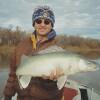Now here’s something you’ll never see in Minnesota or North Dakota.
I came across a story from the Idaho Statesman newspaper the other day about a walleye “invasion” in Lake Lowell, a southwestern Idaho lake known for its largemouth bass fishing.
ADVERTISEMENT

As a result of the unwanted influx, Idaho’s Fish and Game department is asking anglers to have at it with the walleyes, the Idaho Statesman reported. No limits; instead, anglers should “catch, kill and keep” every walleye they catch.
The fish apparently were illegally introduced by a fisherman in 2022, the Statesman reported, and may “be competing and taking food from largemouth bass.” The population has “advanced quickly” since 2022, fisheries biologist Art Butts told the newspaper.
“Idaho and walleye just aren’t a good match in most places,” the newspaper said, citing a news release from Idaho Fish and Game.
“Just because there’s places in the Midwest that do really good with walleye, and they haven’t impacted largemouth bass ... that doesn’t mean that they’re not going to have an impact here,” Butts told the Statesman.
Given the mindset of many anglers in Minnesota and North Dakota, where “if it’s not a walleye, it’s not a fish” is a common perception, it might be hard to grasp the concept of walleyes being an undesirable species.
But just like any invasive species, walleyes can have a big-time impact on the ecology of lakes and rivers where they don’t belong. And once the genie’s out of the bottle, so to speak, reversing the impact is difficult, if not impossible.
That’s no different than any other invasive species, whether it’s zebra mussels or jumping carp.
ADVERTISEMENT
As the Statesman reported, Idaho’s Fish and Game is encouraging anglers to target walleyes, even though it probably won’t fix the problem.
As the old saying goes: When life gives you lemons, make lemonade.
“We know that angling by itself is probably not going to do much for the population,” Butts says in the article. “Walleye are considered one of the best-eating fish in freshwater, and so while we’ve got this problem, let’s get the word out to folks that might be interested in fishing for them.
“Here’s a place where you ... have a good opportunity to do that.”
This isn’t the first time fisheries managers have raised the alarm about walleyes, of course. The Columbia River has long had a population of unwanted walleyes, to the detriment of native salmon species, and now has a reputation as a trophy walleye fishery. As with Lake Lowell in Idaho, there’s no size or bag limit on walleyes in the Columbia River.
There have been other instances of unwanted game fish species, as well, and not just walleyes. According to the National Park Service, non-native lake trout were discovered in Wyoming’s Yellowstone Lake in 1994. Since then, millions of lake trout have been removed from Yellowstone Lake through gillnetting, in an effort to lower the population and lessen the negative impact on native cutthroat trout. Other techniques, such as spreading plant-based pellets over lake trout spawning sites to suffocate the eggs,
Lake trout are probably my favorite fish to catch, and walleyes are right up there. Just goes to show, I guess – one angler’s prize is another angler’s problem.
ADVERTISEMENT
Bobber watching fun
I’ve said it before, and I’ll probably say it again:
There’s something about watching a bobber that just never gets old.
I thought about that again last weekend, when I got the chance to spend a few hours walleye fishing on Devils Lake.
My fishing partners had been over there a few days already and had done well dunking leeches below slip bobbers in about 15 feet of water, give or take, the previous two mornings. Eater-size fish, mostly, with their biggest stretching the tape at 19½ inches.
That fish went back in the lake to hopefully make more anglers’ bobbers sink sometime down the road.
Expecting a spot to produce walleyes three days in a row might be a stretch, especially in a location as small as this particular area, but we decided to give it a few hours anyway.
Boat traffic certainly wouldn’t be a problem. Even though it was a holiday weekend, I was struck by how quiet the lake was – at least in the area where we were fishing. We didn’t see more than a handful of boats the whole time.
ADVERTISEMENT
Not that I’m complaining, mind you.
The action was considerably slower than what my fishing partners had experienced the previous two days – just my luck – but we still managed to put three eaters in the box during our short time on the water.
I had the pleasure of watching my bobber sink to a 17-inch walleye.
I’ll take fish like that any day of the week. And if getting to watch a bobber sink is part of the deal, all the better.









